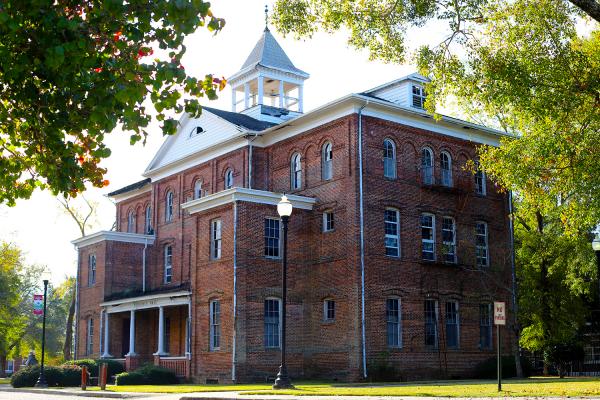Eight HBCUs Awarded Grants for Cultural Stewardship Planning

Tuskegee University is one of eight HBCUs to receive a grant through the Historically Black Colleges and Universities Cultural Heritage Stewardship program. Tuskegee will develop a stewardship plan for Thrasher and Sage Halls, designed by noted African American architect Robert R. Taylor.
Photo by Kwesi Daniels, courtesy National Trust for Historic Preservation

Tuskegee University is one of eight HBCUs to receive a grant through the Historically Black Colleges and Universities Cultural Heritage Stewardship program. Tuskegee will develop a stewardship plan for Thrasher and Sage Halls, designed by noted African American architect Robert R. Taylor.
Photo by Kwesi Daniels, courtesy National Trust for Historic Preservation
WASHINGTON, D.C.—Eight Historically Black Colleges and Universities (HBCUs) were awarded more than $650,000 in grants today through the HBCU Cultural Heritage Stewardship Initiative, a partnership between the National Endowment for the Humanities (NEH) and the National Trust for Historic Preservation. The program provides HBCUs with resources to protect, preserve, and leverage their historic campuses, buildings, and landscapes, ensuring these symbols of African-American excellence and American achievement are preserved to inspire and educate future generations.
With an initial investment of more than $1 million, the selected HBCUs will develop cultural heritage stewardship plans for either a campuswide site or for an individual building or site. These plans are intended to guide the grantees as they define preservation solutions to existing architectural or landscaping challenges and to identify a course of action that helps conserve their historic resources. The plans will also assist the HBCUs as they leverage funding and resources to restore and rehabilitate campus facilities.
“The National Endowment for the Humanities is proud to help support the preservation of the historic structures and campuses that are part of the enduring legacy of our nation’s HBCUs,” said NEH Acting Chairman Adam Wolfson. “These institutions have played a vital role in fostering excellence, providing opportunity, and nurturing community for Black Americans. Today’s awards will help strengthen our HBCUs, allowing them to continue to educate and inspire new generations of students.”
The HBCU Cultural Heritage Stewardship Initiative was launched last year by the National Trust’s African American Cultural Heritage Action Fund with $500,000 in support from NEH. It is a $1 million initiative that offers the colleges funding but also leverages the National Trust for Historic Preservation’s 70 years of experience and expertise to help guide the restoration and preservation process at each college or university. Additional funding for the initiative was provided by the Ford Foundation, JPB Foundation, J.M. Kaplan Fund, and Executive Leadership Council.
“HBCUs are keepers of an important American legacy, said National Trust President and CEO, Paul Edmondson,” and many of these institutions are home to important, irreplaceable historic assets that require investment to retain and adapt them for modern use. The National Trust is pleased to offer its expertise and know-how to support the exceptional commitment of these institutions to preserve their heritage for future generations. These grants will ensure that they are well equipped to address numerous preservation challenges and will serve as a model for further HBCU preservation.”
The eight HBCU awardees are:
-
Benedict College (Columbia, South Carolina) to develop a stewardship plan for historic Duckett Hall (1925)
-
Jackson State University (Jackson, Mississippi) to develop a campuswide stewardship plan for its 245-acre campus
-
Lane College (Jackson, Tennessee) to develop a stewardship plan for the J. K. Daniels Conference Center (1923)
-
Morgan State University (Baltimore, Maryland) to develop a campuswide stewardship plan for its 150-acre campus
-
Philander Smith College (Little Rock, Arkansas) to develop a stewardship plan for the Sherman E. Tate Student Recreation Center (1936)
-
Spelman College (Atlanta, Georgia) to develop a stewardship plan for the Rockefeller Fine Arts Building and Site (1964)
-
Stillman College (Tuscaloosa, Alabama) to develop a stewardship plan for Winsborough Hall (1922)
-
Tuskegee University (Tuskegee, Alabama) to develop a stewardship plan for Thrasher Hall (1895) and Sage Hall (1927)
“The HBCU stewardship grant affords us the opportunity to preserve JSU’s history and the surrounding community we serve,” said Thomas K. Hudson, president of Jackson State University. “Many of our buildings and assets are campus landmarks rooted in significant movements and moments of an evolving Mississippi landscape. This grant will certainly be impactful in honoring JSU’s legacy.”
In addition to the planning grant, each HBCU awardee will receive funding for a student professional development opportunity, enabling one student from each campus to work alongside the project team of architects, engineers, and consultants. This support is provided through the HBCU Cultural Heritage Stewardship Initiative, in partnership with the Wunsch Americana Foundation, Chipstone Foundation, and James Marston Fitch Charitable Foundation. These paid positions will support building a more diverse and equitable field of African-American preservationists.
Dr. Roslyn Clark Artis, President and CEO of Benedict College, said, "We are excited to be among the first HBCUs to receive a Cultural Heritage Stewardship Grant from the Trust. Duckett Hall is one of our most utilized academic buildings, a place of tremendous significance to the college. This award enables us to develop a comprehensive plan to ensure its sustainability and longevity for generations to come.”
Since their founding in the 1830s, the number of HBCUs has grown to 105 congressionally designated schools that tell the remarkable story of African-American activism and the fight for education equality. These campuses and landscapes—many of which were designed and built by African-American architects and students—display beauty, ingenuity, and craftsmanship, and serve as landmarks in their communities. Since listing HBCUs collectively as one of the 11 Most Endangered Historic Places in the United States in 1998, the National Trust has advocated and worked to strengthen the stewardship capacity of HBCUs, while also raising national awareness of their significance.
NEH and the National Trust for Historic Preservation, through its African American Cultural Heritage Action Fund, aim to grow the leadership and preservation capacity of HBCUs that steward some of the most diverse and exceptional historic assets in the world.
National Endowment for the Humanities: Created in 1965 as an independent federal agency, the National Endowment for the Humanities supports research and learning in history, literature, philosophy, and other areas of the humanities by funding selected, peer-reviewed proposals from around the nation. Additional information about the National Endowment for the Humanities and its grant programs is available at neh.gov.
National Trust for Historic Preservation: The National Trust for Historic Preservation, a privately funded nonprofit organization, works to save America’s historic places. http://savingplaces.org | @savingplaces
African American Cultural Heritage Action Fund: The African American Cultural Heritage Action Fund is a multiyear initiative of the National Trust for Historic Preservation in partnership with the Ford Foundation, the JPB Foundation, the Open Society Foundations and other partners, working to make an important and lasting contribution to our cultural landscape by elevating the stories and places of African American achievement and activism. Visit http://www.savingplaces.org/actionfund
